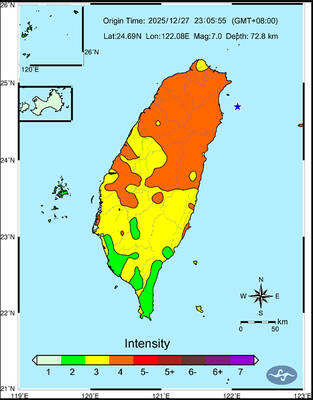The Ministry of National Defense yesterday confirmed the passage of a US warship and a US supply ship through the Taiwan Strait on Monday.
The ships sailed northward and left the Strait in the early hours of yesterday morning, the ministry said.
The military was fully aware of the situation and there were no unusual incidents, it added.
The two ships were the USS Stethem and the USNS Cesar Chavez, a statement released by the US Pacific Fleet said.
“This routine transit through international waters of the Taiwan Strait demonstrates the US commitment to a free and open Indo-Pacific,” the Pentagon said in a statement.
The US Department of Defense “will continue to fly, sail and operate anywhere international law allows,” it said.
Monday’s event was the second time this year that US military vessels have passed through the Strait, and the fifth such passage in the past eight months.
The US Navy on Jan. 24 sailed the Arleigh Burke-class destroyer USS McCampbell and fleet replenishment oiler USNS Walter S. Diehl through the Strait.
Minister of National Defense Yen De-fa (嚴德發) rejected speculation that the US decision to send military vessels through the Strait indicated a problem with regional stability, the Central News Agency reported.
The Taiwanese military has the ability to ensure safety in the Taiwan Strait, an unnamed military official said.
Last autumn, Chinese People’s Liberation Army Navy (PLAN) vessels began carrying out routine patrols along the median line of the Strait, the official said, adding that in the past, China generally only sent military vessels through the Strait to carry out specific missions.
Taiwan, on the other hand, has been sending navy vessels on routine patrols in the Strait for decades, the official added.
The PLAN’s routine patrols have increased pressure on Taiwan to be prepared militarily so that, now, the military mainly dispatches Cheng Kung-class frigates, with Knox-class frigates serving as support, the official said.
In urgent situations, it might also dispatch fast-attack missile boats to monitor the region, the official said.
Due to safety concerns and in accordance with military preparedness, when a Chinese military vessel enters the Strait, Taiwan sends a vessel to monitor the situation, the official said.
“Where [Chinese military vessels] are, we will be,” the official said, adding that the military would not miss detecting any vessels.
The source did not respond as to whether military vessels from Taiwan, the US and China were ever observed in the same waters, monitoring each other.

A magnitude 7.0 earthquake struck off Yilan at 11:05pm yesterday, the Central Weather Administration (CWA) said. The epicenter was located at sea, about 32.3km east of Yilan County Hall, at a depth of 72.8km, CWA data showed There were no immediate reports of damage. The intensity of the quake, which gauges the actual effect of a seismic event, measured 4 in Yilan County area on Taiwan’s seven-tier intensity scale, the data showed. It measured 4 in other parts of eastern, northern and central Taiwan as well as Tainan, and 3 in Kaohsiung and Pingtung County, and 2 in Lienchiang and Penghu counties and 1

FOREIGN INTERFERENCE: Beijing would likely intensify public opinion warfare in next year’s local elections to prevent Lai from getting re-elected, the ‘Yomiuri Shimbun’ said Internal documents from a Chinese artificial intelligence (AI) company indicated that China has been using the technology to intervene in foreign elections, including propaganda targeting Taiwan’s local elections next year and presidential elections in 2028, a Japanese newspaper reported yesterday. The Institute of National Security of Vanderbilt University obtained nearly 400 pages of documents from GoLaxy, a company with ties to the Chinese government, and found evidence that it had apparently deployed sophisticated, AI-driven propaganda campaigns in Hong Kong and Taiwan to shape public opinion, the Yomiuri Shimbun reported. GoLaxy provides insights, situation analysis and public opinion-shaping technology by conducting network surveillance

‘POLITICAL GAME’: DPP lawmakers said the motion would not meet the legislative threshold needed, and accused the KMT and the TPP of trivializing the Constitution The Legislative Yuan yesterday approved a motion to initiate impeachment proceedings against President William Lai (賴清德), saying he had undermined Taiwan’s constitutional order and democracy. The motion was approved 61-50 by lawmakers from the main opposition Chinese Nationalist Party (KMT) and the smaller Taiwan People’s Party (TPP), who together hold a legislative majority. Under the motion, a roll call vote for impeachment would be held on May 19 next year, after various hearings are held and Lai is given the chance to defend himself. The move came after Lai on Monday last week did not promulgate an amendment passed by the legislature that

AFTERMATH: The Taipei City Government said it received 39 minor incident reports including gas leaks, water leaks and outages, and a damaged traffic signal A magnitude 7.0 earthquake struck off Taiwan’s northeastern coast late on Saturday, producing only two major aftershocks as of yesterday noon, the Central Weather Administration (CWA) said. The limited aftershocks contrast with last year’s major earthquake in Hualien County, as Saturday’s earthquake occurred at a greater depth in a subduction zone. Saturday’s earthquake struck at 11:05pm, with its hypocenter about 32.3km east of Yilan County Hall, at a depth of 72.8km. Shaking was felt in 17 administrative regions north of Tainan and in eastern Taiwan, reaching intensity level 4 on Taiwan’s seven-tier seismic scale, the CWA said. In Hualien, the